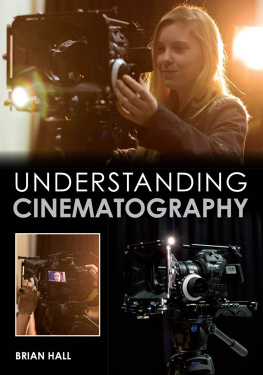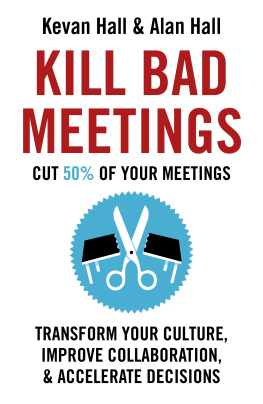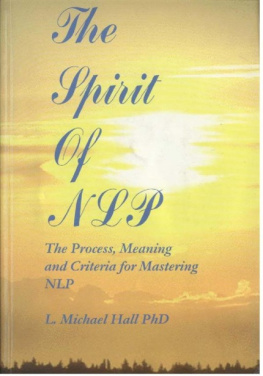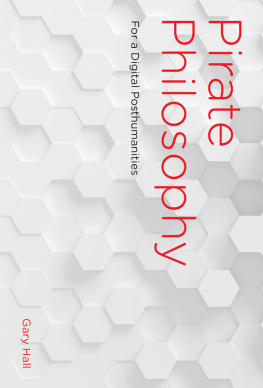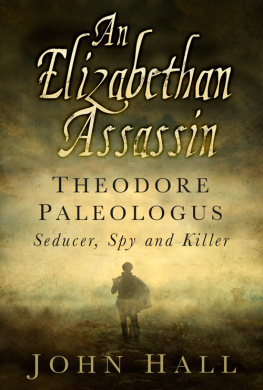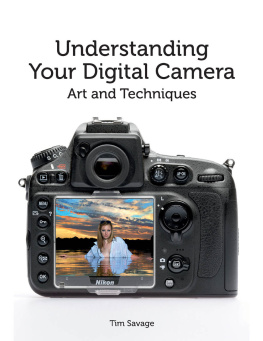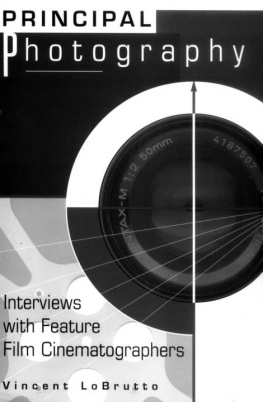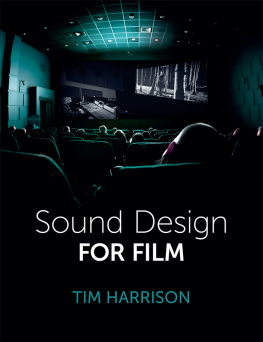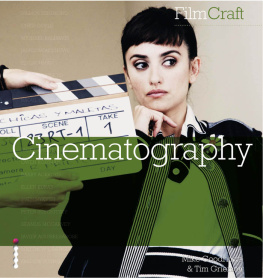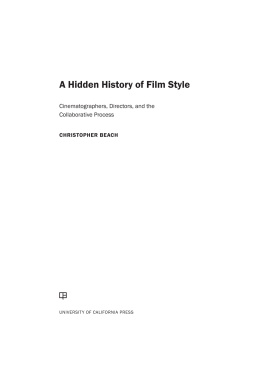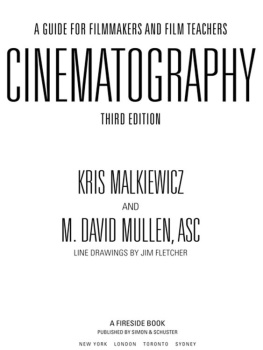
UNDERSTANDING
CINEMATOGRAPHY
BRIAN HALL

THE CROWOOD PRESS
First published in 2015 by
The Crowood Press Ltd
Ramsbury, Marlborough
Wiltshire SN8 2HR
www.crowood.com
This e-book first published in 2015
Brian Hall 2015
All rights reserved. No part of this publication may be reproduced or transmitted in any form or by any means, electronic or mechanical, including photocopy, recording, or any information storage and retrieval system, without permission in writing from the publishers.
British Library Cataloguing-in-Publication Data
A catalogue record for this book is available from the British Library.
ISBN 978 1 84797 992 6
Dedication and Acknowledgements
For Anne, Sam and Jennie.
Writing a book, I discovered, is like producing a film it is essential that you have a great team working with you. So in no particular order, thanks are due to Lincoln School of Film and Media (LSFM) students Thomas Rose for many of the photographs and Claire Smith, for providing the illustrations. My colleagues at LSFM, Chris Hainstock, Grant Bridgeman, Philip Stevens for their thoughts on working relationships within a film production team and Andrew Armstrong for tackling the technical issues of the digital camera. I needed a team of volunteers to be the subjects in several of the photographs, so many thanks are due to Tara Clements, Jennie Hall, Emma Simpson and Gemma Hitchcock. Contributions were also gratefully received from Mike Downing (of LSFM) for the front cover photographs and Jai Mansson for the back cover. Permission to use their photographic images came from Caroline Derry, Chester Hartwell, the National Media Museum, Science and Society Picture Library, the Widescreen Museum, Technicolor, Tiffen, Hague Camera Supports and Aaton cameras. The Lincoln School of Film and Media has an impressive range of facilities, so many thanks to Dr Sarah Barrow, the Head of School for allowing me to use their photo studio and television studios. Last but not least to Anne Hall, for her painstaking efforts in editing my work and encouraging me to keep going!
Contents
Introduction
Once upon a time, in the days before computers and electronic toys, all young boys wanted a train set, and I was no different. I got my train set and over the years enjoyed playing with it and acquired all the extras that made it as realistic a playing experience as it could possibly be. I had several locomotives, lots of track with electric points and even a fully functional coal yard where the coal train would deliver its load via a mechanical hopper system.
You are probably thinking what has that to do with cinematography?
While I still enjoyed playing with the train, I was also developing another passion and that was for the moving image. I was fascinated by what I saw on my parents television set (there were only two channels back then, and they were in black and white), but I was intrigued by the process of how they got onto the screen. Who were the people who travelled to exotic locations to make documentaries? And in particular, who was the person behind the camera and what exactly was their role?
One day my father came home from work and told me a friend of his had bought an 8mm cine camera a few weeks previously but was not enjoying using it. I felt a little jealous because I knew I would love to have a go at shooting some film and, even though I would not be in some exotic location, I was sure I could make some great moving images. I wanted to know more about the camera, the make and the model, so I could find out all about it. The next day my father came home from work with more tales about his friend and his cine camera, including the information I wanted. However he also had some much more interesting news for me: his friends son wanted a train set! You can probably guess the rest of the story. Yes, I swapped my train set for an Admira 8F cine camera and that is when the passion that turned into my career began.
A LIFE BEHIND THE CAMERA
Trains played another small part in my early years behind the camera, when I got my first job working for an industrial film unit that was part of a large aerospace company. There was going to be an air race from the Post Office Tower in London to the Empire State Building in New York, and the Royal Air Force were going to take part, flying one of their Harrier jets. The pilot was to start by travelling on a motorbike from the Post Office Tower to the coal yard behind St Pancras station, where he would then take off in his aircraft. I was despatched to film a train delivering coal and then get shots of the Harrier jet as it landed in the coal yard ready for the race pilot to take off as quickly as possible. The Harrier jet was a vertical take-off and landing aircraft (it needed no runway) and a senior military officer realized that, when it was landing, the down draft from the engines was going to blow coal dust all over the place, covering the many dignitaries, as well as the press, television cameramen (and me) who were waiting to record it. The solution that was suggested was that we should get the fire brigade, who were there for safety reasons, to hose the whole place down with water so that coal dust did not go flying. It was a great idea and we did not get covered in coal dust as expected we all got covered in wet coal dust, which was even worse.
Life behind the camera is full of surprises, and I had my fair share when several years later I began to work as a BBC film lighting cameraman. During my career, I filmed in more than forty countries and met some amazing and inspiring people, just as I had always wanted to do since I was a young boy. I hope that this book will help give you the basic skills to contemplate a career in cinematography.
WHO THIS BOOK IS FOR
This introduction to the art and craft of cinematography and its role in the production process is for sixth-form students in secondary education and students embarking on a certificate or degree course in film production at further education or higher education level.
The aim of the book is to guide you through the basic principles of cinematography so that you have a solid base from which to develop your skills further. Most skills have a set of technical ground rules, designed simply to ensure that things work, and cinematography is no exception. I firmly believe that it is essential for students to understand these rules before questioning their usefulness or breaking them when going about making their own films or videos.
You will learn about the technology, methods of working and the work of the crew. Producing a film is a team effort. Whether you are a cinematographer, sound mixer, make-up artist or director you do not work alone; you operate as part of a team. Therefore it follows that an understanding of the skills and problems of the other team members is essential, especially when you have to solve possible technical problems together. This understanding of others problems also means that on a personal level you will be seen as a good team member do not underestimate this, as it is just as important as technical ability and creative skills when jobs become available. So even if you do not expect to specialize in cinematography, this book will help you gain an understanding of the techniques and skills needed and how the camera team goes about their work.

